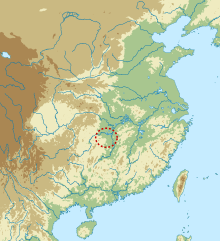Pengtoushan
 | |||||||
| Geographical range | China | ||||||
|---|---|---|---|---|---|---|---|
| Period | Neolithic China | ||||||
| Dates | 7500–6100 BC | ||||||
| Type site | Pengtoushan | ||||||
| Major sites | Bashidang | ||||||
| Chinese name | |||||||
| Traditional Chinese | 彭頭山文化 | ||||||
| Simplified Chinese | 彭头山文化 | ||||||
| |||||||
The Pengtoushan culture, dating 7500–6100 BC,[1] was a Neolithic culture centered primarily around the central Yangtze River region in northwestern Hunan, China. It was roughly contemporaneous with its northern neighbor, the Peiligang culture. The two primary examples of Pengtoushan culture are the type site at Pengtoushan and the later site at Bashidang.
The type site at Pengtoushan was discovered in Li County, Hunan. This site is the earliest permanently settled village yet discovered in China.[2] Excavated in 1988, Pengtoushan has been difficult to date accurately, with a large variability in dates ranging from 9000 BC to 5500 BC.[2] Cord-marked pottery was discovered among the burial goods.
Analysis of Chinese rice residues which were Carbon-14 dated to 8200–7800 BC show that rice had been domesticated by this time.[3] The size of the Pengtoushan rice was larger than the size of naturally occurring wild rice; however, Pengtoushan lacked evidence of tools used in cultivating rice. Although not found at Pengtoushan, rice-cultivating tools were found in later sites associated with the Pengtoushan culture.
See also
References
- ↑ Miriam T. Stark (2006). Archaeology of Asia. Wiley-Blackwell. p. 84. ISBN 1-4051-0212-8.
- 1 2 Charles Higham (1996). The Bronze Age of Southeast Asia. Cambridge University Press. p. 63. ISBN 0-521-56505-7.
- ↑ Kwang-chih Chang, Pingfang Xu, Sarah Allan, Liancheng Lu (2005). The Formation of Chinese Civilization. Yale University Press. p. 298. ISBN 0-300-09382-9.